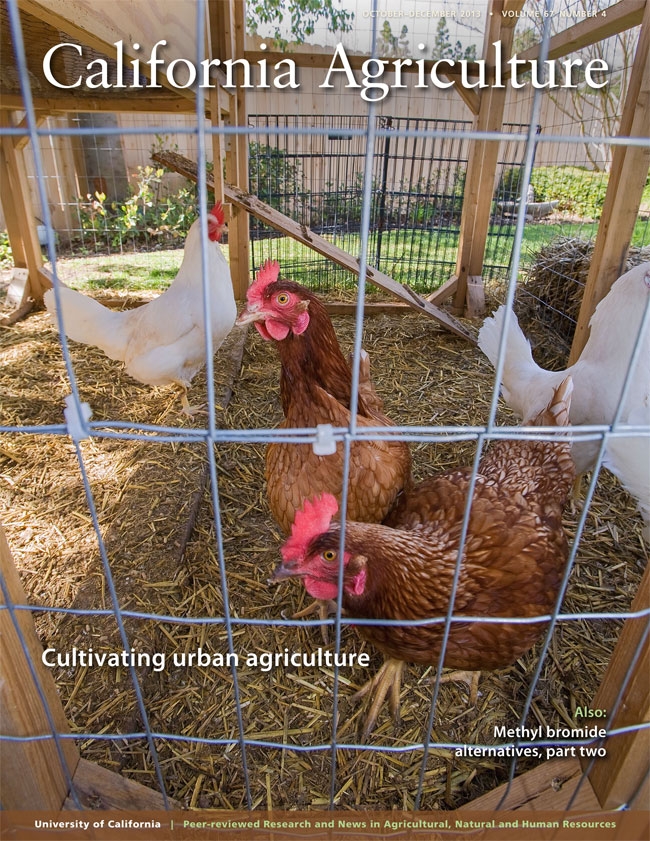
Called the CAHFS Backyard Flock program, this service is funded by the California Department of Food and Agriculture as a biosecurity measure.
"Urban chicken owners generally aren't trained to recognize to recognize signs of illness, there are few if any chicken vets in the city, and online forums are not moderated by experts," says CAHFS researcher Sarah Stinson, lead author of the article.
The study showed that Backyard Flock submissions rose nearly fourfold between 2007 and 2012. Chickens accounted for 91 percent of submissions, and the greatest increases were in Santa Clara, Los Angeles and Sonoma counties. Diagnoses revealed that the birds' digestive and hemolymphatic systems were most commonly affected, and that the most common illness was Marek's disease, a highly contagious virus that can kill up to 80 percent of infected birds.
However, only an estimated 2 percent of amateur poultry keepers are aware of and have used the Backyard Flock program. To decrease the biosecurity risk of infectious diseases in backyard poultry, the researchers recommend advertising this disease testing service as well as reliable information about keeping backyard flocks healthy. For example, backyard chicken websites and online forums could be invited to add links to government websites, programs and information.
Besides keeping their flocks disease-free, people should keep hens in coops that protect them from cats and other urban predators, and give them specially formulated chicken feed from feed stores rather than chicken scratch or scraps. Moreover, even where chickens are legal, it's a good idea to talk to the neighbors before setting up a coop. Ways to earn goodwill include keeping hens in the coop until neighbors are awake, sharing eggs and, most of all, forgoing roosters, which can crow loudly day and night.
Link to full article: Popular Backyard Flock program reduces biosecurity risks of amateur production
Also in this issue of California Agriculture journal:
Testing protocol ensures the authenticity of organic fertilizers
After major "organic" fertilizer suppliers were found using cheaper inorganic compounds, the state gave the California Department of Food and Agriculture the authority to verify organic fertilizers starting in 2010. But there has been no good way to test whether fertilizers are actually organic. Now, UC researchers have developed an inexpensive method for distinguishing organic from synthetic fertilizers. This method assesses N15, an isotope of nitrogen that is relatively high in organic sources; ammonium, which is relatively low in most organic sources; and the ratio of carbon to nitrogen, which has a characteristic value for a given organic source.
Soil type, crop and irrigation all influence optimal nitrogen management
Groundwater can be contaminated by nitrate, and most of this contamination comes from fertilizer applied to crops. It makes intuitive sense to address this problem by managing nitrogen on farms, and this is the approach recommended by the California State Water Resources Control Board. However, new research shows that nitrate levels in groundwater are also affected by soil type and rainfall, which cannot be managed, as well as by irrigation and crop type, which can. Rather than focusing solely on nitrogen management, the researchers call for best management practices that also include irrigation management and that can be tailored individually to farms.
These research articles and the entire October-December 2013 issue can be downloaded at: http://californiaagriculture.ucanr.edu.
California Agriculture is the University of California's peer-reviewed journal of research in agricultural, human and natural resources. For a free subscription, go to: http://californiaagriculture.ucanr.edu, or write to calag@ucanr.edu.
The University of California's Division of Agriculture and Natural Resources is the bridge between local issues and the power of UC research. UC ANR's advisors, specialists and faculty bring practical, science-based answers to Californians. Visit ucanr.edu to learn more.
WRITERS/EDITORS: To request a hard copy of the journal, e-mail crllopez@ucanr.edu